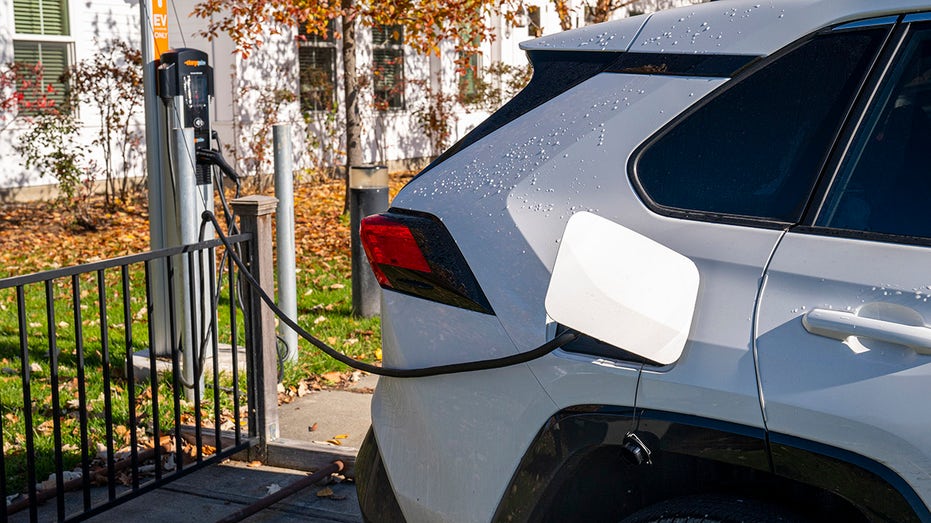Fox Business Flash top headlines for August 12
Check out what’s clicking on FoxBusiness.com.
Passage of the Inflation Reduction Act (IRA) will change the way people buy electric cars for the next decade, and it might make it harder for many.
The current system allows automakers to build up to 200,000 plug-in light vehicles of any type or price that qualify buyers for a maximum $7,500 tax credit, prorated for the size of the battery pack. After the threshold is reached, the credit phases out by half and then half again over the course of year.
Tesla and General Motors have entirely exhausted their eligibility and Toyota is in the phase-out period, with Nissan and Ford expected to enter it next.
| Ticker | Security | Last | Change | Change % |
|---|---|---|---|---|
| TSLA | TESLA INC. | 859.89 | -23.18 | -2.62% |
| GM | GENERAL MOTORS CO. | 38.46 | +0.51 | +1.34% |
| TM | TOYOTA MOTOR CORP. | 158.60 | +0.71 | +0.45% |
The IRA removes the cap and allows the subsidy to be applied at the point of purchase, so the sale price can be immediately reduced. This eliminates the need to file for the credit on a tax return, but a host of new restrictions are being put in place, including the first income and price limits.
ELECTRIC CAR SURVEY FINDS THIS AS THE BIGGEST REASON PREVENTING PEOPLE FROM BUYING THEM
Several Tesla models will be disqualified from the credit based on price. (Paul Bersebach/MediaNews Group/Orange County Register via Getty Images / Getty Images) The credit will only available to single-filers who earn less than $150,000 annually, heads of households at $225,000 and couples at $300,000. The procedure for confirming eligibility at the time of purchase has not yet been clarified. The maximum price for a car that qualifies will also be restricted to $55,000, while SUVs and pickups will be limited to $80,000. They also must be assembled in North America, which will disqualify many models as soon as the law goes into effect. All Ford Mustang Mach-E models should qualify for the credit since the EPA classifies it as a utility vehicle. (David Paul Morris/Bloomberg via Getty Images) Source: Consumer Reports The Treasury Department is expected to release an official list by the end of the year. However, additional rules are scheduled to go into effect in 2023 will split the subsidy in two. One half will be based on manufacturing location and the other on the country of origin of critical metals used in the batteries. At least 40% will need to be sourced from the United States or countries it has a free trade agreement with, and the number will increase each year until it reaches 100% in 2029. Additionally, half the battery's overall value must meet the same country of manufacture rules as the rest of the vehicle or the credit is lost. ELECTRIC CAR COMPANY REVEALS WHY PEOPLE REALLY BUY ELECTRIC CARS John Bozzella, CEO of the Alliance for Automotive Innovation trade group that represents most of the automakers who do business in the U.S., said 70% of the full electric and plug-in hybrid vehicles that are currently available will be made ineligible right off the bat, and that number could potentially drop to zero as the industry works to update its supply chain to meet the new regulations. The Japan-built Toyota Rav4 Prime plug-in hybrid will not qualify for the new credit due to its requirement that vehicles be assembled in North America. (Robert Nickelsberg/Getty Image) "The $7500 credit might exist on paper, but no vehicles will qualify for this purchase incentive over the next few years. That’s going to be a major setback to our collective target of 40-50 percent electric vehicle sales by 2030," Bozzella wrote on the group’s website. Bozzella said the Alliance supports the long-term goals of the bill, but thinks changes need to be made to make it effective at achieving its goal of increasing the number of plug-in vehicles purchased in the U.S. "One straightforward adjustment to the bill that can help achieve this? Expanding the definition of eligible countries from which batteries, battery components and critical minerals can be sourced to include nations that have collective defense arrangements with the United States, like NATO members, Japan and others. Broadening the list of eligible countries will provide more options to more quickly reduce our reliance on China," Bozzella said. CLICK HERE FOR MORE ELECTRIC CAR NEWS "The bill's stringent vehicle eligibility requirements may cause confusion and potential disappointment in the market as consumers will automatically assume that all BEVs will qualify for the credit right away, which won't be the case," Jessica Caldwell, Edmunds' executive director of insights told FOX Business. "The pressure will be on automakers to satisfy the bill's ambitious requirements quickly as shoppers will want answers when they find out the EV they desire doesn't qualify for a full, or even partial, tax credit." The major automakers have not offered any guidance ahead of the bill’s passage, but Rivian and U.S. based startup automakers Lucid and Fisker are all allowing their customers to enter non-refundable purchase agreements now that they say will lock in the existing $7,500 credit for their soon-to-be disqualified models, even if they are not delivered until after the law goes into effect. GET FOX BUSINESS ON THE GO BY CLICKING HERE A used car credit worth up to $4,000 or 30% of the sale price, whichever is lower, is also being instituted, but it carries its own slate of requirements. The income thresholds are cut in half to $75,000 for single filers, $112,500 for heads of households and $150,000 for couples filing jointly, but the car has to be at least two years old and the sale price $25,000 or less, or $40,000 for a commercial vehicle. The credit only applies to the first resale of the vehicle. The new credits are slated to be available through 2032. The Associated Press contributed to this report Source: Read Full Article

Qualifying Vehicles Available This Year

Ticker
Security
Last
Change
Change %
RIVN
RIVIAN AUTOMOTIVE INC.
38.95
+0.01
+0.01%
LCID
LUCID GROUP INC.
18.59
+0.49
+2.74%
FSR
FISKER INC.
9.62
+0.39
+4.27%







